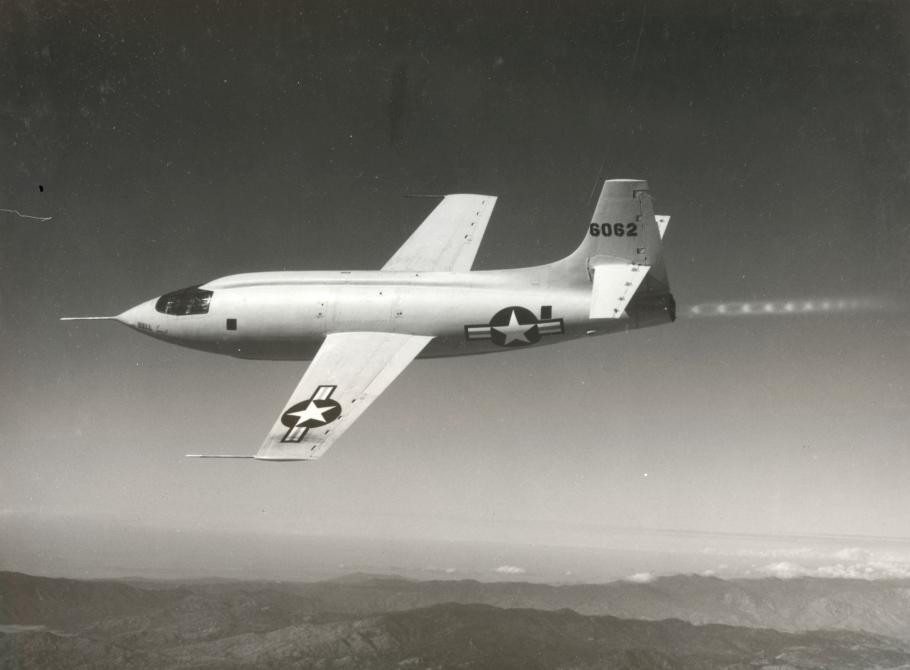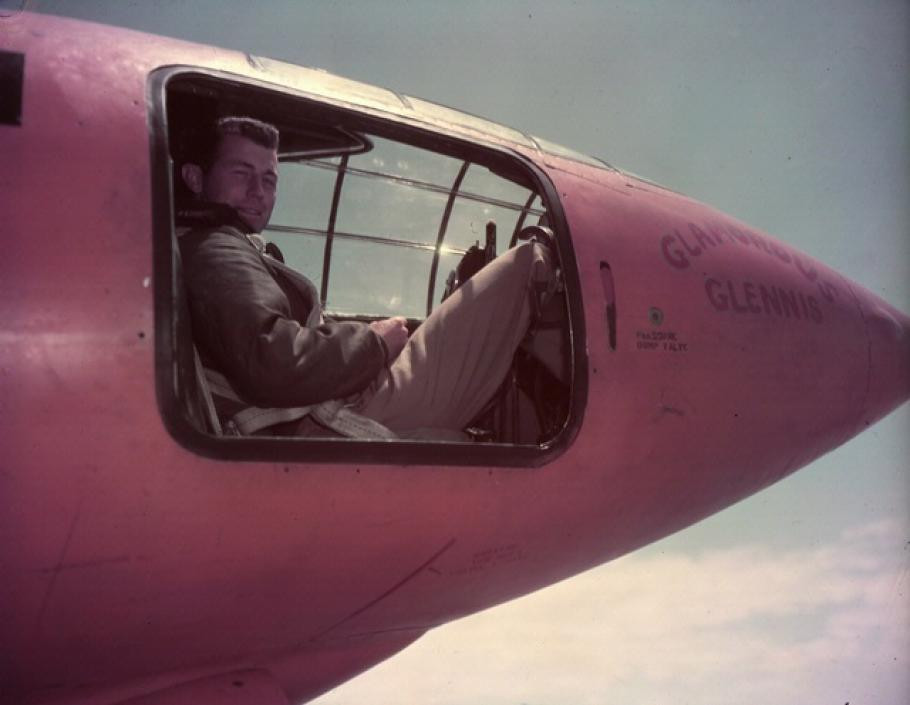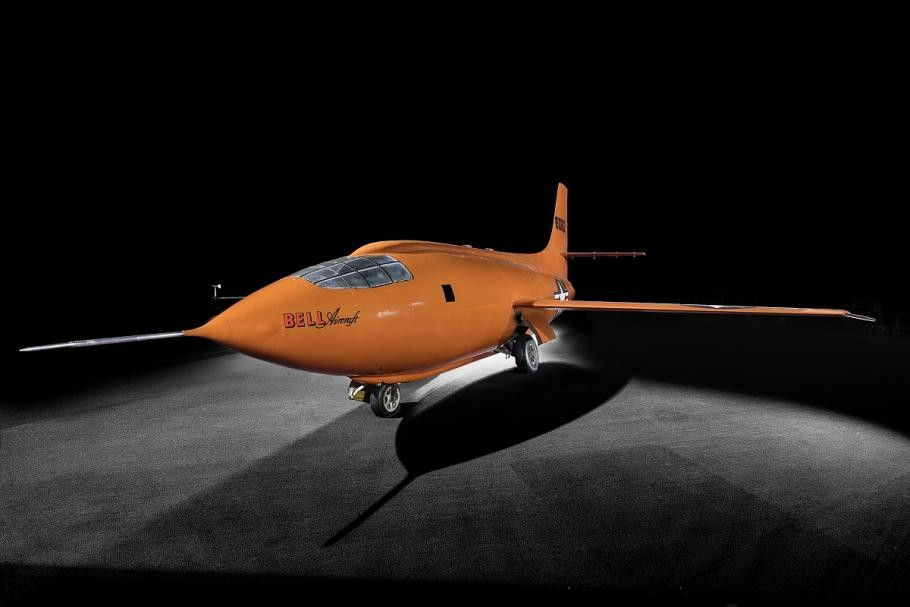The phenomenon of A Plane Breaking The Sound Barrier results in a sonic boom, a powerful release of energy, and significant changes in aerodynamics; streetsounds.net, is your go-to source for exploring this captivating world of sonic phenomena and high-speed flight, providing a vast library of sound effects, expert articles, and a vibrant community for enthusiasts and professionals alike, also, you can find related aviation sounds, sonic boom recordings, and experimental aircraft sounds.
1. What Exactly Happens When an Aircraft Breaks the Sound Barrier?
When an aircraft breaks the sound barrier, it transitions from subsonic to supersonic speed, creating a shock wave that results in a sonic boom, aerodynamic changes, and significant energy release.
Understanding the Sound Barrier
The sound barrier isn’t a physical wall but rather the point at which an aircraft reaches the speed of sound, approximately 767 mph (1,235 km/h) at sea level. As an aircraft accelerates, it compresses the air in front of it, creating pressure waves. At subsonic speeds, these waves move faster than the aircraft, allowing the air to smoothly flow around it. However, as the aircraft approaches the speed of sound, these pressure waves compress, forming a single, high-pressure shock wave.
The Sonic Boom Phenomenon
The sonic boom is the audible result of the shock wave created when an aircraft flies at supersonic speeds. This boom is often described as a loud thunderclap or explosion and can be startling to those on the ground. According to NASA, a sonic boom is a continuous noise that follows the aircraft as long as it remains at supersonic speed. The intensity of the sonic boom depends on factors such as the size and shape of the aircraft, its altitude, and atmospheric conditions.
Aerodynamic and Structural Changes
Breaking the sound barrier also introduces significant aerodynamic challenges. At transonic speeds (around Mach 0.8 to Mach 1.2), the airflow around different parts of the aircraft can be both subsonic and supersonic. This mixed flow creates complex aerodynamic forces, including increased drag and instability. Aircraft designed to fly at supersonic speeds, like the Bell X-1, incorporate features such as swept wings and streamlined fuselages to mitigate these effects.
 Side view of light-colored aircraft in flight. Aircraft features multiple U.S. military star inside circle with bar emblems.
Side view of light-colored aircraft in flight. Aircraft features multiple U.S. military star inside circle with bar emblems.
Historical Context
The first confirmed instance of an aircraft exceeding the speed of sound was on October 14, 1947, when Chuck Yeager piloted the Bell X-1 Glamorous Glennis. This milestone was the culmination of extensive research and development efforts during World War II and the early Cold War era. The X-1 program provided critical data on transonic and supersonic flight, paving the way for future advancements in aviation.
Modern Applications
Today, many military aircraft are designed to fly at supersonic speeds. Commercial supersonic travel has been limited, with the Concorde being the most notable example. However, there is renewed interest in developing supersonic and even hypersonic passenger aircraft. These advancements aim to reduce travel times and revolutionize air transportation.
2. What Causes a Sonic Boom When a Plane Breaks the Sound Barrier?
A sonic boom is caused by the formation of shock waves when an aircraft exceeds the speed of sound, creating a sudden and intense burst of acoustic energy.
Formation of Shock Waves
As an aircraft moves through the air, it creates pressure waves that travel at the speed of sound. When the aircraft approaches Mach 1 (the speed of sound), these pressure waves begin to compress and coalesce in front of the aircraft. Once the aircraft exceeds Mach 1, these compressed waves form a shock wave, a region of abrupt change in pressure, density, and temperature.
Pressure Build-Up and Release
The shock wave is essentially a cone of high-pressure air that emanates from the aircraft. As this cone passes over an observer on the ground, they experience a sudden and dramatic increase in pressure, followed by an equally rapid decrease. This rapid pressure change is perceived as a sonic boom. The louder the boom, the greater the pressure change.
Factors Affecting Sonic Boom Intensity
Several factors influence the intensity of a sonic boom. These include the aircraft’s size, shape, speed, and altitude. Larger aircraft and higher speeds generally produce more intense sonic booms. Additionally, atmospheric conditions such as temperature and humidity can affect how shock waves propagate through the air.
Mitigating Sonic Booms
Efforts to reduce the impact of sonic booms have led to innovative aircraft designs. For example, some designs aim to create a “shaped sonic boom” that minimizes the intensity of the shock wave reaching the ground. NASA’s Low Boom Flight Demonstrator project is focused on developing technologies to reduce the loudness of sonic booms, making supersonic flight more acceptable for commercial use.
Real-World Examples
The effects of sonic booms can range from minor disturbances to structural damage. In populated areas, regulations often restrict supersonic flight to minimize noise pollution. However, military training areas and designated test ranges are common locations where supersonic flights are permitted.
Streetsounds.net Resources
Streetsounds.net offers a variety of resources for those interested in learning more about sonic booms. The site includes recordings of actual sonic booms, detailed explanations of the physics behind them, and discussions about the impact of supersonic flight on urban environments. These resources provide valuable insights for researchers, engineers, and aviation enthusiasts alike.
3. What Are the Aerodynamic Effects When an Airplane Goes Supersonic?
When an airplane transitions to supersonic speeds, it encounters significant aerodynamic changes, including increased drag, shock wave formation, and altered lift characteristics.
Increased Drag
One of the most significant challenges of supersonic flight is the dramatic increase in drag. At subsonic speeds, air flows smoothly around the aircraft, resulting in relatively low drag. However, as the aircraft approaches and exceeds the speed of sound, the formation of shock waves creates significant pressure gradients. These pressure gradients lead to a form of drag known as wave drag, which can be several times greater than subsonic drag.
Shock Wave Formation
As discussed earlier, shock waves form when an aircraft flies at supersonic speeds. These waves not only produce sonic booms but also affect the airflow around the aircraft. The interaction between the shock waves and the boundary layer (the thin layer of air closest to the aircraft’s surface) can lead to boundary layer separation, further increasing drag and reducing lift.
Altered Lift Characteristics
The lift generated by an aircraft’s wings also changes significantly at supersonic speeds. Subsonic airfoils (wing shapes) are designed to accelerate air over the upper surface, creating lower pressure and generating lift. However, at supersonic speeds, the airflow over the wing is governed by shock waves. This can lead to a loss of lift and a shift in the center of pressure, affecting the aircraft’s stability.
Design Considerations for Supersonic Aircraft
To overcome these aerodynamic challenges, supersonic aircraft incorporate several design features. These include:
- Swept Wings: Swept wings reduce the effects of wave drag by delaying the formation of shock waves.
- Thin Airfoils: Thin airfoils minimize the strength of shock waves and reduce drag.
- Area Rule: The area rule, developed by NASA engineer Richard Whitcomb, dictates that the cross-sectional area of the aircraft should change smoothly from nose to tail. This reduces wave drag by minimizing the strength of shock waves.
- Variable Geometry Wings: Some supersonic aircraft, such as the F-14 Tomcat, use variable geometry wings, which can be adjusted to optimize performance at both subsonic and supersonic speeds.
Practical Implications
The aerodynamic effects of supersonic flight have significant implications for aircraft design, performance, and fuel efficiency. Overcoming these challenges requires advanced engineering and careful consideration of the principles of aerodynamics.
Streetsounds.net as a Resource
Streetsounds.net provides a unique perspective on these aerodynamic phenomena by offering sound recordings and analyses of supersonic aircraft in flight. These resources can help engineers and researchers better understand the acoustic signatures of supersonic flight and develop strategies for noise reduction.
4. What Types of Aircraft Are Capable of Breaking the Sound Barrier?
Various types of aircraft, including fighter jets, experimental planes, and some commercial airliners, are capable of breaking the sound barrier, each designed with specific features to handle supersonic flight.
Fighter Jets
Fighter jets are the most common type of aircraft designed to fly at supersonic speeds. These aircraft are built with powerful engines, aerodynamic designs, and advanced control systems to achieve and maintain supersonic flight. Examples include the F-22 Raptor, F-35 Lightning II, and the Eurofighter Typhoon.
Experimental Aircraft
Experimental aircraft like the Bell X-1, which was the first aircraft to break the sound barrier, are designed to test new technologies and explore the limits of flight. These aircraft often push the boundaries of what is possible, providing valuable data for future aircraft designs.
Commercial Airliners
The Concorde was the most famous example of a commercial airliner capable of supersonic flight. It flew passengers between London and New York in about half the time of a subsonic airliner. However, due to high operating costs and noise concerns, the Concorde was retired in 2003.
Business Jets
Several companies are currently developing supersonic business jets, aiming to provide faster travel options for business executives and other high-net-worth individuals. These aircraft are designed to be more fuel-efficient and quieter than the Concorde, making them more viable for commercial use.
Design Features
Aircraft capable of breaking the sound barrier share several common design features:
- Powerful Engines: Supersonic aircraft require engines that can produce a significant amount of thrust to overcome drag.
- Aerodynamic Design: These aircraft feature streamlined fuselages, swept wings, and thin airfoils to reduce drag and improve stability.
- Advanced Control Systems: Supersonic flight requires sophisticated control systems to manage the complex aerodynamic forces encountered at high speeds.
- Heat-Resistant Materials: High speeds generate significant heat due to air friction, so supersonic aircraft must be built with materials that can withstand these temperatures.
Future Trends
The development of new materials, engine technologies, and aerodynamic designs is paving the way for more efficient and quieter supersonic aircraft. These advancements could lead to a resurgence of supersonic commercial travel in the coming years.
Streetsounds.net Insights
Streetsounds.net offers a collection of audio recordings featuring a diverse array of aircraft, encompassing both subsonic and supersonic models. This compilation furnishes listeners with an unparalleled chance to scrutinize and contrast the distinct auditory characteristics intrinsic to each kind of aircraft. Furthermore, the platform furnishes expert evaluations pertaining to the acoustic footprint of supersonic aircraft, thereby offering valuable enlightenment for communities residing in proximity to flight routes.
5. How Did Chuck Yeager Break the Sound Barrier in the Bell X-1?
Chuck Yeager broke the sound barrier on October 14, 1947, piloting the Bell X-1 Glamorous Glennis through a combination of skill, innovative aircraft design, and incremental testing.
Background
Charles “Chuck” Yeager was a U.S. Air Force test pilot with extensive flight experience. He was selected to pilot the Bell X-1 because of his exceptional flying skills, his ability to provide detailed feedback, and his calm demeanor under pressure.
The Bell X-1 Aircraft
The Bell X-1 was an experimental rocket-powered aircraft designed specifically to explore supersonic flight. It featured a bullet-shaped fuselage, thin wings, and an adjustable horizontal stabilizer. The aircraft was air-launched from a B-29 bomber to conserve fuel and reach high altitudes.
The Flight
On the day of the historic flight, Yeager climbed into the X-1, which was attached to the belly of the B-29. After reaching an altitude of 20,000 feet, the X-1 was released. Yeager then ignited the X-1’s rocket engine, accelerating the aircraft towards the speed of sound.
Overcoming Buffeting
As the X-1 approached Mach 1, Yeager encountered severe aerodynamic buffeting, which made the aircraft difficult to control. However, engineers had recently upgraded the aircraft’s adjustable stabilizer, allowing Yeager to make instantaneous incremental changes in the angle of attack, which smoothed out the airflow as the aircraft approached the speed of sound maintaining elevator effectiveness.
Breaking the Sound Barrier
On this, the ninth powered flight of the X-1, the Mach meter jumped from Mach .965 to Mach 1.06—faster than the speed of sound. The transition to supersonic flight was remarkably uneventful. After flying under power from the XLR-11 rocket engine for 20 seconds, Yeager cut the power and glided down to the lakebed for a safe landing. The world’s first piloted supersonic flight had lasted 14 minutes from release from the B-29 to landing.
Significance
Yeager’s successful flight proved that supersonic flight was possible and paved the way for future advancements in aviation. The data gathered during the X-1 program were immediately applied to a new generation of high-performance combat aircraft, such as the North American F-100, America’s first supersonic fighter, during the early years of the Cold War.
Yeager’s Legacy
Chuck Yeager became a legendary figure in aviation history. His courage, skill, and determination inspired generations of pilots and engineers. He continued to fly and test aircraft for many years, contributing significantly to the advancement of aviation technology.
 Chuck Yeager in Bell X-1
Chuck Yeager in Bell X-1
Streetsounds.net Tribute
Streetsounds.net celebrates Chuck Yeager’s achievement by featuring recordings of the Bell X-1 and sonic booms, as well as interviews with aviation experts who discuss the impact of his historic flight. These resources provide a comprehensive understanding of the challenges and triumphs of early supersonic flight.
6. What Role Did the Bell X-1 Play in Supersonic Flight Research?
The Bell X-1 played a crucial role in supersonic flight research by providing critical data on transonic and supersonic aerodynamics, validating theoretical models, and paving the way for future aircraft designs.
Data Collection
The primary mission of the Bell X-1 program was to gather data on the behavior of aircraft at transonic and supersonic speeds. Instruments on board the X-1 measured various parameters, including air pressure, temperature, and structural loads. This data was invaluable for understanding the complex aerodynamic forces encountered at high speeds.
Validation of Theories
Prior to the X-1 program, much of the understanding of supersonic flight was based on theoretical models and wind tunnel testing. The X-1 flights provided real-world validation of these theories, confirming their accuracy and identifying areas where they needed refinement.
Design Improvements
The X-1 program led to numerous improvements in aircraft design. For example, the X-1’s thin wings and adjustable horizontal stabilizer were innovations that helped to reduce drag and improve stability at supersonic speeds. These design features were later incorporated into many other aircraft.
Pilot Training
The X-1 program also played a role in training pilots for supersonic flight. Chuck Yeager and other test pilots gained valuable experience flying the X-1, developing techniques for controlling aircraft at high speeds. This expertise was essential for the development of future supersonic aircraft.
Legacy
The Bell X-1 program laid the foundation for all subsequent supersonic aircraft. The data and experience gained during the program were directly applied to the design of fighter jets, commercial airliners, and other high-speed aircraft. The X-1 remains a symbol of innovation and a testament to the power of human ingenuity.
 Bell X-1 aircraft photographed from a side angle against a dark backdrop
Bell X-1 aircraft photographed from a side angle against a dark backdrop
Streetsounds.net Archival Material
Streetsounds.net preserves the legacy of the Bell X-1 by offering a collection of historical audio recordings, including interviews with engineers and pilots involved in the program. These resources provide a unique perspective on the challenges and triumphs of early supersonic flight research.
7. How Is the Speed of Sound Measured, and What Is Mach Number?
The speed of sound is measured based on air density and temperature, while Mach number represents the ratio of an object’s speed to the local speed of sound.
Measuring the Speed of Sound
The speed of sound varies depending on the medium through which it is traveling. In air, the speed of sound is primarily affected by temperature and density. The higher the temperature, the faster the speed of sound. At sea level, under standard conditions (20°C or 68°F), the speed of sound is approximately 767 miles per hour (1,235 kilometers per hour).
Factors Affecting the Speed of Sound
Several factors can affect the speed of sound:
- Temperature: As temperature increases, air molecules move faster, allowing sound waves to propagate more quickly.
- Density: Higher density generally increases the speed of sound, although the relationship is more complex in gases.
- Humidity: Humidity has a slight effect on the speed of sound, as water vapor is less dense than air.
Mach Number
Mach number is a dimensionless quantity representing the ratio of an object’s speed to the local speed of sound. It is named after Austrian physicist Ernst Mach. Mach 1 is equal to the speed of sound, Mach 2 is twice the speed of sound, and so on.
Calculating Mach Number
The formula for calculating Mach number is:
Mach Number = (Object’s Speed) / (Local Speed of Sound)
For example, if an aircraft is flying at 1,534 mph at an altitude where the speed of sound is 767 mph, its Mach number would be 2.
Importance of Mach Number
Mach number is an important parameter in aviation and aerodynamics. It is used to classify different speed regimes:
- Subsonic: Mach number less than 1
- Transonic: Mach number between 0.8 and 1.2
- Supersonic: Mach number greater than 1
- Hypersonic: Mach number greater than 5
Applications
Understanding Mach number is crucial for designing aircraft, missiles, and other high-speed vehicles. It is also used in wind tunnel testing and computational fluid dynamics to simulate the behavior of airflow around objects at different speeds.
Streetsounds.net Educational Resources
Streetsounds.net offers educational resources that explain the concepts of the speed of sound and Mach number in detail. These resources include articles, videos, and interactive simulations that help users understand the physics behind supersonic flight.
8. What Are Some of the Challenges in Designing Supersonic Aircraft?
Designing supersonic aircraft presents numerous challenges, including managing heat, drag, noise, and ensuring structural integrity at high speeds.
Heat Management
One of the most significant challenges in designing supersonic aircraft is managing the heat generated by air friction. As an aircraft flies at supersonic speeds, the air around it is compressed, causing the temperature to rise dramatically. This heat can damage the aircraft’s structure and affect the performance of its engines and other systems.
Drag Reduction
As discussed earlier, drag increases significantly at supersonic speeds. Reducing drag is essential for improving fuel efficiency and increasing the aircraft’s range. Supersonic aircraft incorporate design features such as swept wings, thin airfoils, and area ruling to minimize drag.
Noise Reduction
Sonic booms can be a major source of noise pollution, particularly in populated areas. Reducing the intensity of sonic booms is a key challenge in designing supersonic aircraft for commercial use. Researchers are exploring various techniques for shaping sonic booms to minimize their impact on the ground.
Structural Integrity
Supersonic aircraft must be able to withstand the extreme forces and temperatures encountered at high speeds. This requires the use of strong, lightweight materials and advanced structural designs. Engineers must carefully analyze the stress and strain on the aircraft’s structure to ensure its integrity.
Engine Performance
Engines for supersonic aircraft must be able to produce a significant amount of thrust while operating efficiently at high speeds. This requires advanced engine designs and materials. Additionally, the engine inlet must be designed to efficiently capture and compress air, even at supersonic speeds.
Environmental Impact
Supersonic aircraft can have a significant environmental impact, including increased fuel consumption and emissions. Reducing the environmental footprint of supersonic aircraft is an important goal for designers and engineers.
Regulatory Issues
Supersonic flight is subject to various regulations, including noise restrictions and airspace limitations. Navigating these regulatory issues can be a significant challenge for manufacturers of supersonic aircraft.
Streetsounds.net Technical Insights
Streetsounds.net provides technical insights into the challenges of designing supersonic aircraft through interviews with engineers and researchers. These resources offer valuable information for those interested in the technical aspects of supersonic flight.
9. How Are Sonic Booms Being Mitigated in Modern Aircraft Design?
Modern aircraft designs mitigate sonic booms through innovative aerodynamic shaping, advanced control systems, and optimized flight paths, aiming to reduce their intensity and impact.
Aerodynamic Shaping
One of the most promising approaches to mitigating sonic booms is aerodynamic shaping. By carefully designing the shape of the aircraft, engineers can control the way shock waves form and propagate. Some designs aim to create a “shaped sonic boom” that is less intense and more spread out than a traditional sonic boom.
Low Boom Flight Demonstrator
NASA’s Low Boom Flight Demonstrator project is focused on developing technologies to reduce the loudness of sonic booms. The project involves designing and testing an experimental aircraft that incorporates advanced aerodynamic shaping techniques. The goal is to demonstrate that it is possible to build a supersonic aircraft that produces a sonic boom that is no louder than a typical thunderclap.
Advanced Control Systems
Advanced control systems can also be used to mitigate sonic booms. By precisely controlling the aircraft’s attitude and flight path, pilots can minimize the intensity of the shock waves produced. These systems rely on sophisticated sensors and computer algorithms to optimize the aircraft’s performance in real-time.
Optimized Flight Paths
The flight path of a supersonic aircraft can also affect the intensity of its sonic boom. By flying at higher altitudes and avoiding populated areas, pilots can reduce the impact of sonic booms on the ground. Additionally, researchers are exploring the use of curved flight paths to disperse shock waves and reduce their intensity.
Materials and Structures
The materials and structures used in supersonic aircraft can also play a role in mitigating sonic booms. Lightweight materials can reduce the overall weight of the aircraft, improving its fuel efficiency and reducing its noise emissions. Additionally, advanced structural designs can help to minimize the vibration and noise generated by the aircraft.
Community Engagement
Engaging with communities affected by sonic booms is an important part of mitigating their impact. By providing information about supersonic flight and listening to community concerns, aircraft manufacturers and operators can build trust and reduce opposition to supersonic flight.
Streetsounds.net Community Forum
Streetsounds.net hosts a community forum where users can discuss the impact of sonic booms and share ideas for mitigating their effects. This forum provides a valuable platform for dialogue between aviation professionals and the public.
10. What Future Innovations Might Make Supersonic Flight More Common?
Future innovations in materials, propulsion, and aerodynamics hold the potential to make supersonic flight more common by addressing challenges related to efficiency, noise, and cost.
Advanced Materials
The development of new materials is essential for improving the performance and efficiency of supersonic aircraft. Lightweight materials such as carbon fiber composites can reduce the weight of the aircraft, improving its fuel efficiency and range. Additionally, heat-resistant materials can help to manage the high temperatures encountered at supersonic speeds.
Improved Propulsion Systems
Advanced propulsion systems are needed to improve the fuel efficiency and reduce the noise emissions of supersonic aircraft. Researchers are exploring various engine technologies, including variable cycle engines, which can be optimized for both subsonic and supersonic flight. Additionally, efforts are underway to develop quieter engine designs that minimize the noise generated by supersonic aircraft.
Aerodynamic Advancements
Aerodynamic advancements can help to reduce drag and mitigate sonic booms. Researchers are exploring various techniques for shaping the aircraft’s fuselage and wings to minimize the intensity of shock waves. Additionally, advanced control systems can help to optimize the aircraft’s performance in real-time, reducing drag and noise.
Sustainable Fuels
The use of sustainable fuels can help to reduce the environmental impact of supersonic flight. Sustainable fuels can be produced from renewable resources, such as algae or biomass, and can significantly reduce greenhouse gas emissions. Additionally, sustainable fuels can help to reduce the reliance on fossil fuels, improving energy security.
Automation and Artificial Intelligence
Automation and artificial intelligence can play a role in improving the safety and efficiency of supersonic flight. Automated systems can help to reduce pilot workload and improve decision-making. Additionally, AI algorithms can be used to optimize flight paths and control systems, reducing drag and noise.
Infrastructure Development
The development of new infrastructure is needed to support the growth of supersonic flight. This includes the construction of new airports and the modernization of existing facilities. Additionally, investments in air traffic control systems are needed to safely and efficiently manage supersonic aircraft.
Regulatory Reform
Regulatory reform can help to create a more favorable environment for supersonic flight. This includes streamlining the certification process for new aircraft and updating noise regulations to reflect the latest technological advancements. Additionally, governments can provide incentives for the development of sustainable fuels and other environmentally friendly technologies.
Streetsounds.net Vision
Streetsounds.net envisions a future where supersonic flight is more common, affordable, and environmentally sustainable. The site is committed to providing resources and information that support the development of innovative technologies and policies that can make this vision a reality.
Dive deeper into the world of sound with streetsounds.net! Explore our extensive library of sound effects, articles, and community forums. Your next sound adventure starts here. Address: 726 Broadway, New York, NY 10003, United States. Phone: +1 (212) 998-8550.
FAQ About a Plane Breaking the Sound Barrier
1. What is the sound barrier?
The sound barrier is the point at which an aircraft reaches the speed of sound, approximately 767 mph (1,235 km/h) at sea level. This is not a physical barrier but a phenomenon related to the behavior of air as an aircraft approaches this speed.
2. What happens when an aircraft breaks the sound barrier?
When an aircraft breaks the sound barrier, it creates shock waves due to the compression of air. These shock waves result in a sonic boom, which is a loud, thunder-like sound heard on the ground.
3. What is a sonic boom?
A sonic boom is the sound associated with the shock waves created when an object travels through the air faster than the speed of sound. It sounds like a loud explosion or thunderclap.
4. How is the speed of sound measured?
The speed of sound is measured based on air density and temperature. At sea level, under standard conditions (20°C or 68°F), the speed of sound is approximately 767 miles per hour (1,235 kilometers per hour).
5. What is Mach number?
Mach number is the ratio of an object’s speed to the speed of sound. Mach 1 is equal to the speed of sound, Mach 2 is twice the speed of sound, and so on.
6. What types of aircraft can break the sound barrier?
Fighter jets, experimental aircraft, and some commercial airliners like the Concorde are capable of breaking the sound barrier.
7. What was the Bell X-1?
The Bell X-1 was an experimental rocket-powered aircraft that was the first to break the sound barrier, piloted by Chuck Yeager on October 14, 1947.
8. Who was Chuck Yeager?
Chuck Yeager was a U.S. Air Force test pilot who was the first person to break the sound barrier in the Bell X-1 aircraft.
9. What are some of the challenges in designing supersonic aircraft?
Challenges include managing heat, drag, noise, and ensuring structural integrity at high speeds.
10. How are sonic booms being mitigated in modern aircraft design?
Modern aircraft designs mitigate sonic booms through aerodynamic shaping, advanced control systems, and optimized flight paths, aiming to reduce their intensity and impact.


